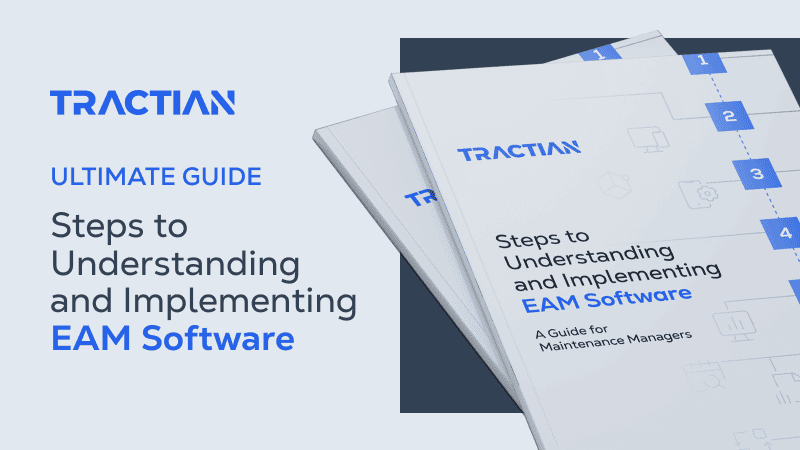How can you improve what you aren’t aware of? Remember the old saying, “out of sight, out of mind?” This fact is a cold, hard truth that most industrial maintenance teams deal with and struggle with daily.
Relying on scattered data or delayed updates is a risky situation. And, given rising inventory costs, tighter compliance pressures, and the daily challenge of keeping assets online, it’s also very expensive.
We all know that visibility into your maintenance operations is the foundation of every informed decision your team makes. When visibility isn’t part of your team’s foundation, your team isn’t making informed decisions. If this is your situation, what can you do?
There’s good news for you, because this is where computerized maintenance management systems (CMMS) come into play. They’re not just maintenance software, though. It’s better to think of them as a system of record that turns asset data into real-time insights. Or more simply, the thing that adds visibility to your foundation.
The reports generated from a CMMS aren’t just digital versions of more paperwork. They’re literally the keys to optimizing resource allocation, aligning maintenance strategies, and driving continuous improvement across your plant.
In this guide, we’ll walk through 6 CMMS reports that can help you run a leaner maintenance program like the ones that high-performing teams use. Among their benefits, you’ll see reductions in downtime, control inventory costs, and the assurance that every piece of equipment gets the attention it needs, when it needs it.
Key Performance Indicators Benchmarks
Before diving into detailed reports, it’s worth taking a step back and asking: how do you measure success in maintenance?
KPIs give structure to that answer. Key Performance Indicators directly reflect how well your maintenance team operates, how assets are performing under pressure, and whether your strategy is driving real cost savings or just keeping the lights on.
A CMMS platform that tracks KPIs in real time allows you to leave behind the guessing game, where you’re left “intuiting” whether or not the work you do is achieving the results you need.
Instead of waiting for end-of-month summaries or manually compiling spreadsheets, you get instant visibility into metrics that matter, like mean time to repair, planned maintenance percentage, or wrench time.
These indicators give you the hard proof to validate your preventive maintenance program and justify investments that actually move the needle.
But here’s the critical part: the value of a KPI report isn’t just in showing you where you stand. It’s in showing where you fall short, where your maintenance operations are slipping into reactive maintenance, and where your maintenance strategies need to evolve.
With a well-structured KPI report, you can:
- Identify trends in asset performance that hint at deeper issues
- Compare maintenance data across time periods, shifts, or teams
- Spot gaps in work orders completed on time and flag them before they snowball
It also becomes easier to tie individual maintenance tasks to bigger outcomes like reduced downtime, operational efficiency, and improved productivity. For facility maintenance teams juggling competing priorities, this level of insight is what separates high performers from teams stuck in a reactive cycle.
And because the data comes directly from your CMMS software, it’s clean, contextual, and actionable. These reports don’t just tell you what happened. They help you understand why, and what needs to happen next.
The Importance of Working With KPIs
When your team uses KPIs to monitor gaps between planned vs. executed tasks, you immediately know where delays are creeping in. If your wrench time is consistently low, you’re not looking at a technician issue, you’re looking at a scheduling or prep failure. If time to repair is climbing, it’s either parts unavailability or bad diagnosis flow.
This is where engineers use KPIs to refine the system, not just report on it.
The goal isn’t to admire the data, but to act on it. And when KPIs are integrated directly into your maintenance software, there's no lag, no extra steps, no guesswork. You see where the team stands, right now, not after a quarterly review.
Strict alignment with KPIs and real-time monitoring is how modern facility management is run: live metrics, mapped to actual outcomes. Missed PMs? You catch them before they hit the critical asset. High cost variance? You trace it to a single piece of equipment or a repeated supplier issue.
CMMS Report #1: Created vs. Completed Work Orders
The Created vs. Completed Work Orders report is one of the clearest indicators of whether your maintenance operation is holding the line or falling behind. It tracks every work order that’s generated and compares it to what actually gets completed. The ratio between the two tells you, plainly, if your team has the capacity to execute on the schedule you've built.
If your created WOs are consistently outpacing completed ones, two things are guaranteed: you’re building a backlog, and your preventive maintenance is slipping into reactive territory.
This isn’t just about volume, but about timing. A backlog of unexecuted PMs means critical assets are going longer between inspections, which increases the risk of undetected degradation and failure.
And when work orders aren’t completed on time, it throws off your entire maintenance scheduling structure, making it harder to forecast labor and plan for part replacements.
Use a Created vs. Completed report to:
- Monitor how well your team keeps up with scheduled maintenance tasks
- Identify whether your current labor allocation matches your operational procedures
- Flag excessive reactive maintenance that’s disrupting your PM schedule
It’s also a direct line-of-sight into team performance. A growing delta between created and completed work orders may not mean your team is underperforming. It could mean you’ve overloaded the schedule or you’re missing a layer of work order prioritization.
A strong Created vs. Completed report should be segmented by asset, team, and location. This is how you pinpoint whether delays are localized (one line, one shift) or systemic.
CMMS Report #2: Reactive vs. Repeatable Work Orders
If your work orders are mostly reactive, your maintenance team isn’t in control. You’re just surviving the day.
The Reactive vs. Repeatable Work Orders report gives you visibility into the true balance of your maintenance strategies. It tells you how much of your team’s effort is spent chasing breakdowns versus executing structured, repeatable tasks, like PMs, inspections, and condition-based interventions.
High reactive rates often signal deeper issues like poor preventive planning, unreliable assets, or missed signals from inspections that were either skipped or rushed. And the true cost of these isn’t just in downtime. It's in disorganized labor, delayed spare parts, and overtime that eat into your margins.
Repeatable work orders are the backbone of a proactive approach and make your maintenance responsibilities predictable. They allow your team to prep tools, stage parts, and execute faster, improving wrench time and shrinking time to repair.
In contrast, reactive tasks force last-minute scrambling, which bypasses proper documentation, putting compliance and maintenance records at risk.
What a Reactive Work Order vs. Repeatable Work Order report shows you:
- The proportion of total labor tied to emergency repairs
- Which assets are generating the most reactive calls
- If your PM schedule is reducing failure rates, or just filling the calendar
Once this baseline is clear, the next move is to identify patterns. Is the same piece of equipment triggering unscheduled work repeatedly? Are technicians reworking the same problem with no root cause resolution?
CMMS Report #3: Time vs. Cost
Every maintenance task consumes two resources: hours and dollars. The Time vs. Cost report brings those two into the same view, helping you see if your maintenance work is actually efficient, or just getting done.
This report is less about totals and more about ratios. How much labor time is being spent per work order? Are certain assets consistently racking up more hours than expected? Are your most expensive tasks also your slowest to complete?
When you put labor time next to cost per task, the inefficiencies become impossible to ignore. Maybe your team is taking longer than planned on standard PMs. Maybe you're burning through contractor hours on tasks your team could complete in half the time. Or maybe your parts spend is fine, but your overtime is off the charts.
Use the Time vs. Cost report to:
- Benchmark how long specific task types actually take
- Spot work orders with outlier labor or part costs
- Break down cost drivers by asset, technician, or maintenance type
For managers under pressure to reduce costs, this report delivers hard proof of where your team is winning and where it leaks time and budget. It also feeds directly into your ability to forecast labor needs, justify staffing, and evaluate outsourcing.
CMMS Report #4: Completed with Inspection Check Work Orders
Inspections only work if they’re actually being done and documented properly. The Completed with Inspection Check Work Orders report shows exactly that.
This report verifies whether your team is closing out inspection-based work orders with the required checks performed. It's essential for operations under tight regulatory scrutiny, but it also plays a core role in asset reliability.
When these inspections are skipped, rushed, or closed without documentation, you lose visibility into early signs of degradation, and the entire predictive loop breaks.
If your goal is to shift from firefighting to forecasting, this report is non-negotiable.
Completed with Inspection Check Work Orders helps you:
- Track inspection compliance across assets and timeframes
- Confirm that preventive routines include all necessary verifications
- Identify technicians or shifts with consistent completion issues
It also feeds your ability to enforce accountability without micromanagement. If inspection fields are missing or checklist items go untouched, it's not just a process issue, it’s a safety and liability risk.
CMMS Report #5: On Time vs. Overdue Work Orders
Deadlines in maintenance serve as practical risk thresholds.
The On Time vs. Overdue Work Orders report measures whether your team is completing tasks within the scheduled window or letting them slip. And in industrial environments, missed deadlines often mean increased wear, compliance gaps, or a production stop waiting to happen.
This report gives you a snapshot of execution discipline. It shows whether your preventive tasks are being honored in practice or quietly deferred when things get busy.
That difference might not show up in the first week, but it compounds fast. Overdue work creates uncertainty. It undermines your ability to trust the schedule and makes long-term planning harder.
With an On Time vs. Overdue report, you can:
- Quantify how much of your plan is getting done on time
- Identify which assets or task types are most at risk of delay
- Drill into which shifts or teams are falling behind
And the fix isn’t always obvious. Sometimes delays come from short-staffed crews or misaligned shift planning. Other times, it's inventory delays that push everything downstream. Either way, this report helps you find the constraint.
CMMS Report #6: Time to Complete Work Orders
How long does it actually take your team to close a task from start to finish?
The Time to Complete Work Orders report tracks the full duration of each work order, from the moment it's assigned to the moment it's closed. It’s one of the most telling metrics when it comes to operational flow, resource alignment, and real-world team efficiency.
Unlike wrench time, which looks only at hands-on execution, this report exposes the full picture: delays in approval, part staging issues, and uncoordinated dispatching. If a task that should take 40 minutes routinely takes three hours to close, you're not facing a technical issue. You’re looking at a workflow breakdown.
The Time to Complete report helps maintenance leaders:
- Establish realistic time benchmarks by task type or asset class
- Pinpoint slowdowns in the maintenance chain-planning, execution, or review
- Measure the real impact of scheduling conflicts and missing parts
It’s also a key report when optimizing resource allocation. If your average time to complete is creeping up, it might signal a creeping complexity in tasks, or that your team’s being stretched too thin.
By tracking this across weeks and months, you begin to separate perception from reality. You might find that certain tasks only appear inefficient because the process around them lacks structure. Or that what seems like a technician issue is actually a gap in prep or prioritization.
How Tractian’s CMMS Can Help Your Industry
Modern maintenance doesn’t need more tools. It needs tools that actually work the way maintenance does.
Tractian’s CMMS is built for the shop floor, not just the office. It connects planners and technicians in real time, keeps maintenance data centralized, and gives every team member the visibility to execute with precision.
From logging a task mid-shift to tracking asset performance across weeks, it’s all in one system: accessible, structured, and ready to use.
Need to assign tasks based on priority, not just urgency? That’s built in. Want to make sure SOPs are followed without printing a single sheet? Already done, with AI-generated checklists that structure tribal knowledge into standardized execution.
Missed work, growing backlog, or undocumented inspections? Tractian brings it all to the surface so you can course-correct before it turns into downtime.
And because the platform is mobile-first, your technicians log activity when it happens. No signal? No problem. The app works offline and syncs later, so nothing gets lost and every task is traceable.



